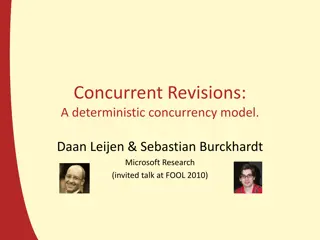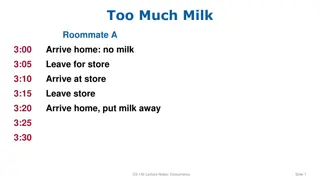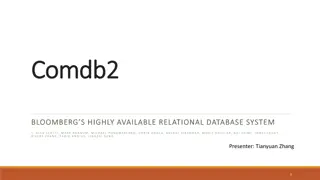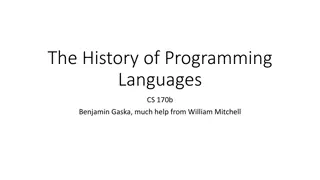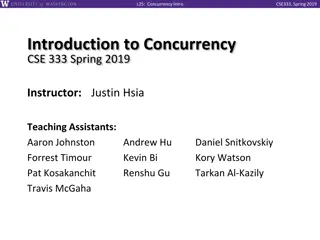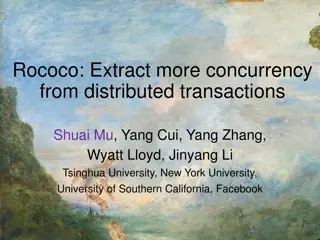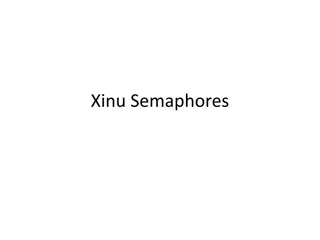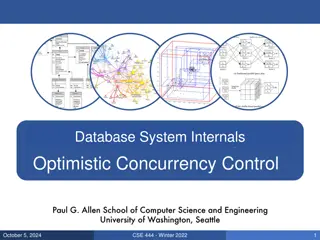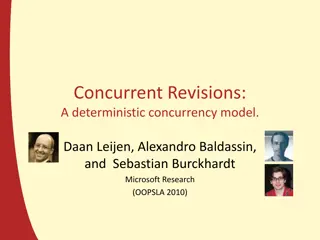A Deep Dive into the Pony Programming Language's Concurrency Model
The Pony programming language is designed for high-performance concurrent programming, boasting speed, ease of learning and use, data race prevention, and atomicity. It outperforms heavily optimized MPI versions in benchmarks related to random memory updates and actor creation. With an API adopted for the EU project UPSCALE and a growing user base, Pony offers a unique approach to concurrency with its actor-based model and innovative garbage collection techniques.
Uploaded on Sep 15, 2024 | 3 Views
Download Presentation

Please find below an Image/Link to download the presentation.
The content on the website is provided AS IS for your information and personal use only. It may not be sold, licensed, or shared on other websites without obtaining consent from the author.If you encounter any issues during the download, it is possible that the publisher has removed the file from their server.
You are allowed to download the files provided on this website for personal or commercial use, subject to the condition that they are used lawfully. All files are the property of their respective owners.
The content on the website is provided AS IS for your information and personal use only. It may not be sold, licensed, or shared on other websites without obtaining consent from the author.
E N D
Presentation Transcript
PONY Sylvan Clebsch, Sebastian Blessing, Sophia Drossopoulou, Andrew Mc Neil Causality Ltd and Imperial College London
Pony a programming language aiming for concurrent (distributed) programming, very fast, easy to learn, easy to use, data-race free and atomicity.
Very fast? GUPS benchmark (from Linpack suite) Measures rate of random updates of memory First Pony implementation (~4 days of work) Pony outperforms heavily optimized MPI version 44% source code reduction
Very fast? Actor creation - (from CAF suite) Create ~1M actors Run on 12 core, 2.3 GHz Opteron, 64 GByte Pony outperforms all except of CAF CAF does no gc
Very fast? Mailbox and Mixed - (from CAF suite) Highly contended mailbox, and mixed case (factorizarion) Run on 12 core, 2.3 GHz Opteron, 64 GByte Pony outperforms all in both
easy to learn, easy to use? Pony API adopted as the back-end for the EU project UPSCALE; API currently used by 10 programmers Pony was taken up by a PhD student after a 2 hour introduction Pony has been unofficially taken up by another 8 programmers in the financial sector We have developed a 10K lines Pony standard library (incl. file handling, collections, networking, http client and server, SSL/TLS, timers and timing, random numbers) We have developed several real world analytics programs Only 10.7% of types require annotations (later)
Remaining talk Pony language design Pony concurrency model Pony Types to prevent data races Pony_ORCA: Garbage Collection Objects Pony_AGC: Garbage Collection Actors Language Design Observations
Pony Concurrency Model Based on actor paradigm Actor ~ active object Actors/objects may send synchronous messages to actors/objects, and asynchronous messages to actors Asynchronous messages stored in queue; executed one at a time No other synchronization primitive Imperative Features Objects may be passed in messages, no copying
Pony Types to prevent data races capability annotations for each type; capabilities ~ points in a matrix of actions denied to local/global aliases deny global read alias write alias deny global Deny nothing to glob.alias
Pony Types to prevent data races capability annotations for each type; capabilities ~ points in a matrix of actions denied to local/global aliases deny global read alias write alias deny global Deny nothing to glob.alias deny local read alias deny local write alias Deny nothing to locl.alias
Pony Types to prevent data races capability annotations for each type; capabilities ~ points in a matrix of actions denied to local/global aliases deny global read alias write alias deny global Deny nothing to glob.alias deny local read alias deny local write alias Deny nothing to locl.alias
Pony Types to prevent data races deny global read alias iso deny global write alias Deny nothing to glob.alias deny local read alias deny local write alias trn val Deny nothing to locl.alias ref box tag
Pony Types to prevent data races what the holder may do deny global read alias iso deny global write alias Deny nothing to glob.alias deny local read alias deny local write alias trn val Deny nothing to locl.alias ref box tag Write Read Ident
Sendable references iso can be sent to other actor after being consumed val and tag can be sent to other actors no copying required deny global read alias iso deny local write alias trn deny global write alias Deny nothing to glob.alias deny local read alias val box Deny nothing to locl.alias ref tag Writeable Readable Opaque
Valid local aliases deny global read alias iso deny global write alias Deny nothing deny local read alias deny local write alias Deny nothing trn val ref box tag Writeable Readable Opaque iso trn val box ref
Valid local aliases deny global read alias iso deny global write alias Deny nothing deny local read alias deny local write alias Deny nothing trn val ref box tag Writeable Readable Opaque box, val iso trn box val ref val, box ref ref box box
Valid local, and global aliases deny global read alias iso deny global write alias Deny nothing deny local read alias deny local write alias Deny nothing trn val ref box tag Writeable Readable Opaque iso trn box val ref val, box ref ref box, val box box val, box val, box
Permanent alias inside an iso-bubble iso iso trn ref val, box CC val, box val box
Permanent and temporary alias inside a iso-bubble iso iso iso trn ref val, box CC val, box val box
Permanent alias inside a trn-bubble trn box box iso trn ref val, box CC val, box val box
Permanent and temporary alias inside a trn-bubble trn box box iso trn iso trn ref val, box CC val, box val box
Pony type system Further issues Recover expressions Type if field read (viewpoint adaptation) Type of method call Type of field write Proofs More at http://www.doc.ic.ac.uk/~scd/fast-cheap.pdf More features implemented Algebraic types and Pattern Matching Generics Non-null More features perhaps Reflection
Pony ORCA: Object Garbage Collection Actors perform GC fully concurrenty. Objects are owned by the actor which created them. Actor garbage collect owned objects. Challenge: objects may be accessible from other actors Approach: Weighted deferred reference counts: actor keep reference count for a) owned objects reachable from other actors, b) objects owned by other actors and reachable from the actor.
Pony ORCA: Object Garbage Collection.2 Actors ( ) , Object (o), owning actor (Own) Actor keep reference count for a) owned objects reachable from other actors, b) objects owned by other actors and reachable from the actor. RC(Own(o),o) = Own(o)RC( ,o) +# {( ,i) | Mssg(a,i) reaches o } When sending/receiving messages, trace, and for all reachable objects adjust RC accordingly. When tracing, and non-owned object becomes inaccessible
Pony ORCA: Object Garbage Collection.2 Actors ( ) , Object (o), owning actor (Own) Actor keep reference count for a) owned objects reachable from other actors, b) objects owned by other actors and reachable from the actor. RC(Own(o),o) + mi where Mssg(Own(o),i)=INC(m,o) = Own(o)RC( ,o) +# {( ,i) | Mssg(a,i) reaches o } When sending/receiving messages, trace, and for all reachable objects o adjust RC accordingly. If RC gets to 0 then add k to own, and send to INC(k+1,o) to Onw(o). When tracing, and non-owned object becomes inaccessible, set own RC to 0, and send INC(-old(RC),o) to Onw(o).
Pony ORCA: Object Garbage Collection.3 Tracing functions using the type system, and therefore no race conditions Used the actor paradigm (messages) to implement garbage collection. Used causal message delivery for Garbage Collection. Object Reference cycles not an issue. More at http://www.doc.ic.ac.uk/~scd/ogc.pdf
Pony Actor Collection Actor collection requires detection of Actor Cycles. This is done by a separate actor the cycle detector. Actors keep a count of all external referring actors, and the set of actors they refer to. When blocking, they send this information to the cycle detector. This information is sufficient for the cycles detector to identify, and remove cycles.
Pony Actor Collection.2 This is done by a separate actor the cycle detector. Actors keep a count of all external referring actors, and the set of actors they refer to. When blocking, they send this information to the cycle detector. But, actors views of themselves may be out of sync with real state (another actor drops/gains reference to them). Also, cycle detector s view of actor may be out of sync with actor s view (a blocked actor may wake up).
Pony Actor Collection.3 This is done by a separate actor the cycle detector. Actors keep a count of all external referring actors, and the set of actors they refer to. When blocking, they send this information to the cycle detector. But, actors views of themselves may be out of sync with real state (another actor drops/gains reference to them). In this case, send appropriate INC/DEC messages. Also, cycle detector s view of actor may be out of sync with actor s view (a blocked actor may wake up). The cycle detector sends ACK, and awaits CONF messages from blocked actors.
Pony Actor Collection.4 Adaptation of reference counting protocol. Used the actor paradigm. Causal Message Delivery a prerequisite. Fun Proof. More at S. Clebsch and S. Drossopoulou. Fully concurrent garbage collection of actors on many-core machines. OOPLSA 2013.
More on Pony Native code compiler Pony actor runtime, including scheduler, memory allocator, message queues, and garbage collector Debugger Several applications developed Implementation fast; language relatively easy to learn/use Even though model is subtle, language feels simple Good defaults and good error messages are crucial Tutorial at http://causalityltd.github.io/pony-tutorial/ Sandbox implementation at http://sandbox.ponylang.org Cheers, Jeers, Help, Collaboration, Feedback, welcome
Language Design Conclusions Actor Paradigm applied to the GC problem; messages sent when an actor s view of world out of sync with the state of world Data Race freedom, Causal Message Delivery prerequisites for Garbage Collection and distribution. Starting from Principles Delivers Formal Models Deliver Finding the Invariant is key Finding ways not to think of time is key






